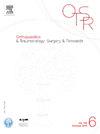围手术期服用度洛西汀可改善抑郁症患者前距腓骨韧带修复术治疗慢性外侧踝关节不稳的术后效果:前瞻性随机临床试验。
IF 2.2
3区 医学
Q2 ORTHOPEDICS
引用次数: 0
摘要
背景:最近的研究表明,抑郁症与足踝手术后持续疼痛和满意度下降有关。本研究旨在评估围手术期使用度洛西汀对抑郁症患者慢性踝关节不稳(CAI)前距腓韧带(ATFL)手术修复术后疗效的影响。我们还试图评估患者对度洛西汀的满意度和副作用:对接受 ATFL 修复术的患者进行术前抑郁筛查,采用患者健康问卷 (PHQ-9)。在 249 名接受了关节镜或开放手术的 ATFL 修复术的患者中,120 名患者被确定为 "可能患有抑郁症",并被纳入研究。60名患者被随机分配到度洛西汀组(术前一天和术后6周),另外60名患者被随机分配到安慰剂组。在术后 12、24、48 和 72 小时以及术后 1、3 和 6 个月的随访中记录止痛药和阿片类药物的用量、疼痛评分和患者满意度。术前以及术后 3、6、12 和 24 个月时对患者报告的结果指标(PROMs)进行了评估。还记录了与度洛西汀相关的副作用,如恶心/呕吐和疲劳:结果:度洛西汀组患者使用镇痛抢救药物的时间明显延长,对阿片类药物(包括塞来昔布、普瑞巴林、对乙酰氨基酚和曲马多)的需求减少。术后 24、48、72 小时以及术后 1 和 3 个月,患者的疼痛强度降低,对疼痛治疗的满意度提高(P < 0.05)。与安慰剂组相比,度洛西汀组在3个月和6个月随访时的临床和功能效果也明显更好(P < 0.05)。度洛西汀副作用症状的发生率和发生率不显著:讨论:抑郁症是一个需要考虑和解决的重要因素,因为在手术前出现抑郁症可预测不良的术后结果,包括更严重的术后疼痛、持续性术后疼痛以及止痛药和阿片类药物用量的增加:结论:抑郁症患者在进行ATFL修复术治疗CAI后,围手术期使用度洛西汀能延长患者术后首次要求使用镇痛药的时间,并减少阿片类药物的用量和术后疼痛。患者对这种方法的满意度也很高。此外,度洛西汀还能提高康复质量,且不会产生明显的副作用:证据级别:I;前瞻性随机对照试验。本文章由计算机程序翻译,如有差异,请以英文原文为准。
Perioperative duloxetine improves postoperative outcomes after anterior talofibular ligament repair for chronic lateral ankle instability for patients with depression: A prospective randomized clinical trial
Background
Recent studies have indicated that depression is associated with persistent postoperative pain and decreased satisfaction following foot and ankle surgery. This study aimed to evaluate the effect of perioperative duloxetine on postoperative outcomes of anterior talofibular ligament (ATFL) surgical repair for chronic ankle instability (CAI) in patients with depression. We further sought to evaluate patients’ satisfaction and side effects related to duloxetine.
Material and methods
Patients undergoing ATFL repair were screened for depression preoperatively with the Patient Health Questionnaire (PHQ-9). Among 249 patients who underwent arthroscopic or open surgical Brostrom repair of the ATFL, 120 patients were identified as being “possibly depressed” and were included in the study. Sixty patients were randomly assigned to the duloxetine group (one day preoperatively and for 6 weeks postoperatively), and the other sixty were randomized to the placebo group. Painkillers and opioid consumption, pain scores, and patient satisfaction were recorded at 12, 24, 48, and 72 hours postoperatively and at follow-up visits 1, 3, and 6 months after surgery. Patient-reported outcome measures (PROMs) were assessed preoperatively and at 3, 6, 12 and 24 months postoperatively. Duloxetine-related side effects such as nausea/vomiting and fatigue were also recorded.
Results
The patients in the duloxetine group reported a significantly longer time to rescue analgesic and reduced opioid requirements (including celecoxib, pregabalin, acetaminophen, and tramadol). The patients experienced decreased pain intensity and greater satisfaction with their pain management at 24, 48, 72 h and 1 and 3 months after surgery (p < 0.05). The duloxetine group also had significantly better clinical and functional outcomes at 3 and 6 months of follow-up compared to the placebo group (p < 0.05). The occurrence and rate of symptoms of duloxetine side effects were not significant.
Discussion
Depression is an important factor to consider and address because its presence before surgery can predict poor postoperative outcomes, including more severe postoperative pain, persistent postoperative pain, and increased consumption of painkillers and opioids.
Conclusion
Perioperative administration of duloxetine following ATFL repair for CAI in patients with depression increased the time to first postoperative rescue analgesic request and reduced both opioid consumption and postoperative pain. This approach also led to a high level of patient satisfaction. In addition, duloxetine improved the quality of recovery without leading to significant side effects.
Level of evidence
I; prospective randomized controlled trial.
求助全文
通过发布文献求助,成功后即可免费获取论文全文。
去求助
来源期刊
CiteScore
5.10
自引率
26.10%
发文量
329
审稿时长
12.5 weeks
期刊介绍:
Orthopaedics & Traumatology: Surgery & Research (OTSR) publishes original scientific work in English related to all domains of orthopaedics. Original articles, Reviews, Technical notes and Concise follow-up of a former OTSR study are published in English in electronic form only and indexed in the main international databases.

 求助内容:
求助内容: 应助结果提醒方式:
应助结果提醒方式:


